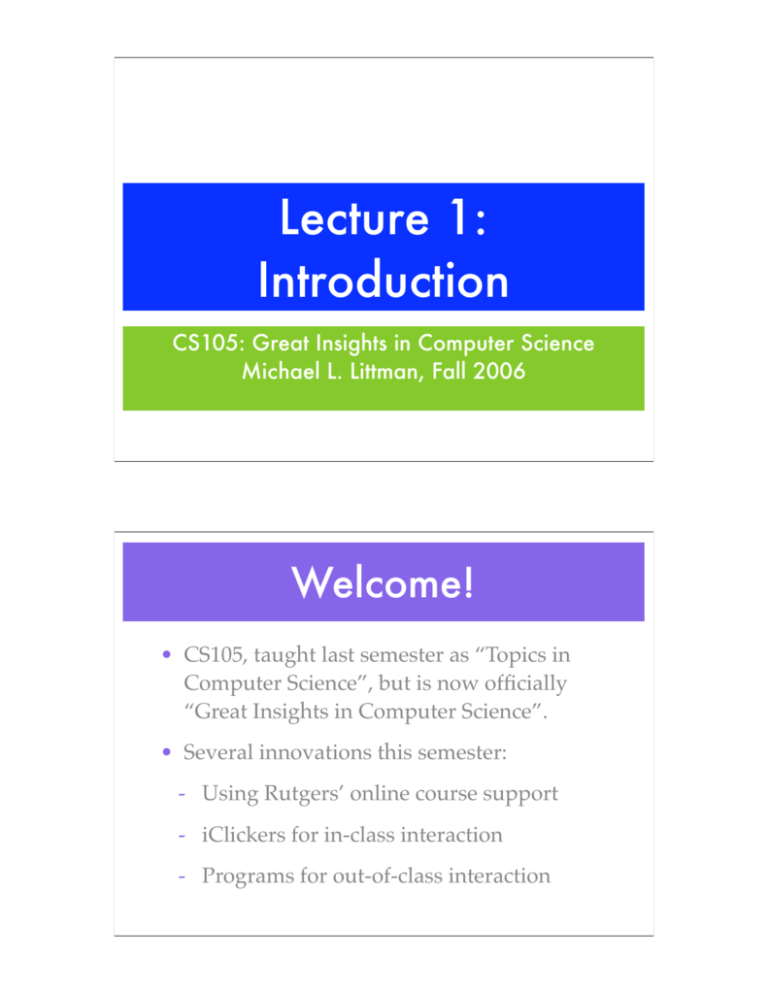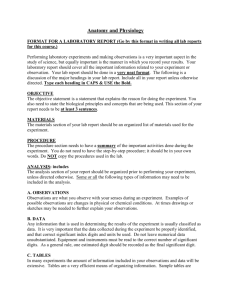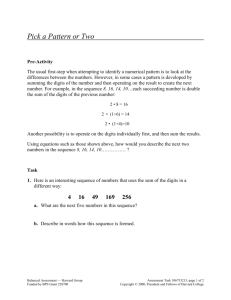Lecture 1: Introduction - Computer Science at Rutgers
advertisement

Lecture 1:
Introduction
CS105: Great Insights in Computer Science
Michael L. Littman, Fall 2006
Welcome!
• CS105, taught last semester as “Topics in
Computer Science”, but is now officially
“Great Insights in Computer Science”.
• Several innovations this semester:
- Using Rutgers’ online course support
- iClickers for in-class interaction
- Programs for out-of-class interaction
Survey
Region 1
Region 2
100
• Do you have a clicker? 75
A. no
50
B. yes
25
0
2004
2005
2006
2007
About Me
• 1996: PhD,
“Algorithms for
Sequential Decision
Making” (AI).
• 1996-1999: Professor at
Duke.
• 2000-2002: (Back) to
NJ, AT&T Labs
Research.
• 2002–: Rutgers:
heading “Rutgers
Laboratory for RealLife Reinforcement
Learning” (RL3).
My Course Goals
• Cool facts, cool ideas. Ideas are “how to”
facts. Shoot for one or two per lecture.
• People (my parents, say), don’t understand
how I have a PhD in CS and can’t help them
when their Windows box crashes.
• If it’s not about XP, what else is there?
- That’s what I want to tell you...
Introduction to CS101s
• Target audience: Undergrads, as a first
(possibly only) computer-science course.
• Seminar in Computers and Society: What
impact have computers had on the world?
• Introduction to Computer Science: How do I
learn to create my own software?
• Introduction to Computers and Their
Application: What do I need to know about
computing technology?
Course Goals: Questions
• What is Computer Science?
• Why is it fun/interesting?
• How is it different from software
engineering?
• What are the insights that make computer
science its own academic discipline?
Textbook
• Not too daunting or
detailed.
• Enjoyable to read; not
really a textbook at all.
• Inspiring and
informative.
• I will add meat to the
wonderful skeleton he
creates.
• Pattern on the Stone, the
simple ideas that make
computers work, Danny
Hillis, Basic Books,
1998.
Clickers
• Available at several
bookstores.
• Can keep them (most
popular clicker at
Rutgers) or sell them
back.
• We’ll use them for
attendence, reading
comprehension
quizzes, straw polls.
• Hope to eventually
add interactive demos,
but software not yet
ready.
http://www.iclicker.com/
Syllabus: Top-level View
Organizing the material into three major
sections:
I. How does a computer work?
II. What do we know about computation?
III. What cool things are computers doing?
I. How Computers Work
• Sequence of easy-to-understand layers.
• Top: high-level programming languages
express ideas in a computer-friendly form.
• Bottom: bits and logic gates, computer's
work done by physical components.
• We'll go bottom up, conceptually creating a
working computer in the process.
II. Computation
• Computers compute. But, what is
computation, and how powerful is it?
• How do computer scientists see the world in
terms of computational problems?
• What’s an algorithm, why might one be
preferred to another if they solve the same
problem?
• What problems can be solved and how fast?
III. Useful Applications
We’ll survey how
computing power is
being harnessed.
• machine learning,
• robotics
• genetic algorithms
• data compression
pattern recognition
• computer graphics
• AI search
• language games
They Are Everywhere!
• 1977: “There
is no reason
for any
individual to
have a
computer in
his home.”
• Today: Cell
phone?
PDA?
Computers at
home?
Laptop?
Video games?
Digital
camera?
Survey
• How many computers are with you right
now? Laptop, handheld game, cell phone,
GPS device, PDA, mp3 player, ...
A. 0
B. 1
C. 2
D. 3
E. 4 or more
Previously Unthinkable
Life After Death?
One-Word Summary
• If I had to summarize
the intellectual
contribution of
computer science in
one word, it would be
“reduction”.
• Computer scientists
solve problems by
reducing them to
simpler problems.
• We’ll see this same
idea played out over
and over again in
different settings...
Levels of Complexity
• Networking (OSI
Layers): application,
presentation, session,
transport, network,
data link, physical.
• Computing:
application, high-level
language, machine
language, logic blocks,
logic gates, physical.
• Vision (Marr):
computational,
algorithmic,
implementation.
• Storage hierarchy:
offline-storage, hard
disk, RAM, cache,
registers.
Today’s Idea
• I will start with the textbook next time,
introducing bits and some simple gates.
• Please read the Preface and Chapter 1,
Section 1.
• But, I want to give you something to chew on
to get those gears turning...
Your Choice
• Babbage’s Difference Engine
- Simple computation for sequences
• How do UPC barcodes work?
- Hierarchy of codes
A. Difference Engine
B. UPC barcodes
Charles Babbage: Facts
• Charles Babbage lived
in England in the
1800s. A polymath, he
solved problems from
Astronomy to
Zoology.
• Invented: cowcatcher,
flat-rate postage,
Operations Research,
standard RR gauge.
• Held Newton’s chair
at Cambridge, but
spent his last years
railing against organ
grinders.
• His design for the
analytical engine
presaged much of the
design of modern
digital computers.
The Difference Engine
• Originally a “computer” was a job
description of a person who created
numerical tables. Useful, if tedious.
• Babbage had a scheme to automate table
creation using “finite differences”.
• 25,000 parts, 15 tons, 8 feet high, never built!
• His redesigned Difference Engine No. 2 was
built in 1990 and actually worked!
Difference Engine: Ideas
Let’s play a game:
• 0,1,2,3,4,__?
• 3,5,7,9,11,__?
• 1,4,9,16,25,__?
• 1,3,6,10,15,__?
Generating the Evens
2 4 6 8 10 12
2 2 2 2 2
Instructions:
Start with 2.
To get the next one, add 2
to the previous one.
1.
2.
Generating Squares
1 4 9 16 25 36
3 5 7 9
11
2 2 2 2
Instructions:
Start with 1.
Start the increment with 3.
To get the next one, add the
increment.
To get the next increment, add 2 to
the previous one.
1.
2.
3.
4.
Naming The Sequences
2 4 6 8 10 12
2 2 2 2 2
The Evens
Sequence: 1,4, 9, 16, 25, 36, ...
1 4 9 16 25 36
11
Program: 3 5 7 9
2 2 2 2
1,3,2
The Squares
Programming the “DE”
• So, to produce the
Evens, we enter “2 2”
into the Difference
Engine and turn the
crank.
• The Squares are “1 3 2”.
• The Triangle numbers
are “1 2 1”.
• Try:
- Odds?
- Count by 5s?
- Cubes?
• What do these do:
- “4”?
- “10 -1”?
- “100 -19 2”?
- “0 1 2 1”?
CS in a Microcosm?
• Get a feel for programming: need to figure
out how to say what you want to say in a
way the machine understands.
• Simple operation (repeated addition) used to
build up more complex objects.
More Advanced Stuff
• Each difference sequence
corresponds to a
polynomial and vice
versa. Why? What is the
relationship between the
length of the difference
sequence and the degree
of the polynomial?
• Can match any finitelength sequence. How
long might the difference
sequence need to be?
• You can start a sequence
at any point by starting
with the corresponding
column. How can a
sequence be moved
backward automatically?
• Download “Python” and
play with it yourself!
http://www.cs.rutgers.edu/~mlittman/
courses/cs442-06/python/
differences.py
Bar Codes
• See http://en.wikipedia.org/wiki/Barcode .
• Many different styles of barcodes.
• Most common is UPC-A, in use in most
North American retail stores.
• I will describe the UPC encoding.
• Many of the same ideas apply to other
codes: checks, photostamps, IR remotes
Universal Product Codes
• First scanned product, Wrigley’s
gun (1974).
• Method of identifying products at
point of sale by 11-digit numbers.
• Method of encoding digit
sequences so they can be read
quickly and easily by machine.
Reduction Idea
• Each level uses an encoding to translate to
the next level.
- Patterns of ink.
- Sequence of 95 zeros and ones.
- Sequence of 12 digits.
- Sequence of 11 digits.
- Name of a retail product.
Product Name
• Ponds Dry Skin Cream
- 3.9 oz (110g)
- Unilever Home and Personal Care USA
• Name Badge Labels ( Size 2 3/16" x 3 3/8")
- 100 Labels
- Avery Dennison/Avery Division
11-Digit Number
• Digit = {0,1,2,3,4,5,6,7,8,9}
• Sequence of 11 digits
• How many different items can they encode?
A. 10,000,000,000
B. 100,000,000,000
C.
9,999,999,999
D. 19,999,999,999
Encode Name By 11 Digits
• First 6 digits: Manufacturer
- First digit, product category:
. 0, 1, 6, 7, 8, or 9: most products
. 2: store’s use, for variable-weight items
. 3: drugs by National Drug Code number
• Last 5 digits: Manufacturer-assigned ID
Examples
• Labels: 0-72782-051440
- 0=general product
- 72782= Avery
- 051440=Avery’s code for this product
• Ponds: 3-05210-04300
- 3=drug code
- 05210= Unilever
- 04300=National Drug Code for this product
12-Digit Number
• The UPC folks decided to include another
digit for error checking. Example:
- 01660000070 Roses Lime Juice (12 oz)
- 04660000070 Eckrich Franks, Jumbo (16 oz)
- 05660000070 Reese PB/Choc Egg (34 g)
- 08660000070 Bumble Bee Salmon (14.75 OZ)
• Misread digit #2 and you turn sweet to sour.
Check Digit
1. Add the digits in the odd-numbered
positions (first, third, fifth, etc.) together and
multiply by three.
2. Add the digits in the even-numbered
positions (second, fourth, sixth, etc.) to the
result.
3. Subtract the result from the next-higher
multiple of ten. The result is the check digit.
Code and Example
def checkDigit(d1,d2,d3,d4,d5,d6,d7,d8,d9,d10,d11):
step1 = (d1+d3+d5+d7+d9+d11)*3
step2 = step1+d2+d4+d6+d8+d10
01660000070
step3 = (-step2)%10
odd-digit sum: 0+6+0+0+0+0=6
return step3
even-digit sum: 1+6+0+0+7=14
odd*3+even = 6*3+14=32
subtract from mult of 10=40-32=8
• Lime juice: 01660000070!016600000708
• Franks:
04660000070!046600000705
• Choc Egg: 05660000070!056600000704
• Salmon:
08660000070!086600000701
all are two
digits different
now
Bits
• We’ve gone from a product name to an 11-digit
number to a 12-digit number. Next: bits.
• abcdefghijkl!101abcdef01010 ghijkl
ghijkl101
Digits encoded as 7-bit
patterns, chosen to be:
•as different as possible
•start with 0, end with 1
•switch from 0 to 1 twice
•no more than 4 of the
same bit in a row
Last 6 digits have 0s
and 1s reversed!
0: 0001101 5: 0110001
1: 0011001 6: 0101111
2: 0010011 7: 0111011
3: 0111101 8: 0110111
4: 0100011 9: 0001011
How Many Bits?
• From our 12-digit number, how many bits
(zeros and ones) long is the code now?
A. 84
B. 95
C. 100
D. 23
E. 12
Finally, Ink!
• Given the long pattern of bits, we write a 1 as
a bar and a zero as a space.
• Two 1s in a row become a double wide bar.
• Two 0s in a row become a double wide space.
• Never have more than 4 in a row.
• Starts and ends with bars.
Example
.......
• Barcode for skin cream:
• 3-05210-04300-8 (8 is the check digit)
start: 101; 3: 0111101
05210: 0001101-0110001-0010011-0011001-0001101
middle: 01010
04300: 1110010-1011100-1000010-1110010-1110010 (rev)
8: 1001000 (rev); end: 101
• The digits underneath are for our benefit.
Close Up
10101111010001101011000100100110011001000110101010111001010111001000010111001011100101001000101
Summary
• Product name turned to 11-digit code
• 11-digit code extended to 12 digits by adding
a check digit
• 12 digits become a 95-bit sequence
• 95 bits are drawn in ink 1=black,0=white
Reverse the process to get the product!
Next Time
• Get iClicker
• Read Hillis: Preface and Chapter 1, up to
and including “Boolean Logic”.
• We’ll have a brief iClicker quiz on the
material.









